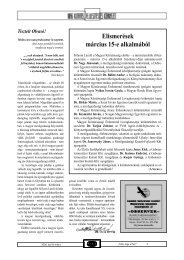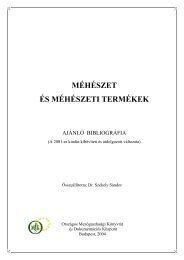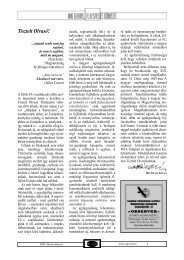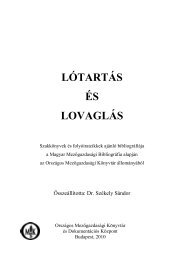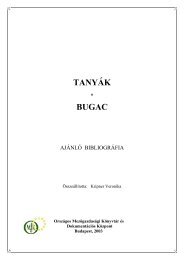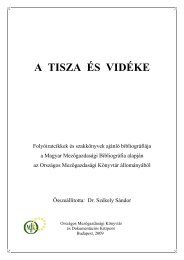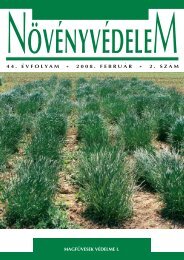hUNGARiAN AGRicUltURAl RESEARch
hUNGARiAN AGRicUltURAl RESEARch
hUNGARiAN AGRicUltURAl RESEARch
You also want an ePaper? Increase the reach of your titles
YUMPU automatically turns print PDFs into web optimized ePapers that Google loves.
seed maturing. The producers in<br />
Hungary actually took advantage<br />
of this phenomenon, and the seeds<br />
of ornamental plants sown in<br />
Western and Northern European<br />
countries were produced here in<br />
most of the 20 th century.<br />
Nevertheless, very few of the<br />
foreign varieties were suitable in<br />
all respects for outdoor use in<br />
Hungary. Due to the acceleration<br />
of vital functions mentioned above,<br />
the varieties developed abroad was<br />
rarely in flower all through the<br />
summer. In addition, the varieties<br />
of the limited number of species<br />
available did not provide enough<br />
variegation which is, for obvious<br />
reasons, an essential aesthetic<br />
requirement for ornamental plant<br />
production.<br />
The breeding of annual<br />
ornamental plants began by the<br />
comprehensive variety examination<br />
mentioned earlier, and the<br />
first results were quite promising.<br />
In the beginning, relatively few<br />
species were involved in the<br />
investigations. The first subject of<br />
breeding was Alcea rosea, and<br />
varieties with the exceptional trait<br />
of bursting into flower even in the<br />
first year were developed and<br />
marketed as Hungarian variety<br />
group. They also had more<br />
branches and larger number of<br />
flowers than the biennial varieties<br />
commonly used beforehand, and<br />
became known later in foreign<br />
countries as Hungarian Hollyhock.<br />
By crossing the distinctive<br />
individual plants of these varieties<br />
Tithonia rotundifolia<br />
with a species autochthonous in<br />
Hungary (Alcea biennis), a new<br />
variety group in seven different<br />
colours was created. These plants<br />
were shorter (100 cm) and had<br />
more branches than any of the<br />
varieties previously used, and<br />
produced an even greater flower<br />
mass, bringing international<br />
recognition to them. They were<br />
traded in Hungary as Balaton series<br />
and were introduced to foreign<br />
markets as the purple-pink Silver<br />
Puffs (All-America Selections<br />
Award Winner), and as Majorette,<br />
Cosmos sulphureus tetraploid<br />
and diploid<br />
a colour mixture of colour-stable<br />
varieties (A.A.S. Award Winner,<br />
1975).<br />
These varieties were able to<br />
flower throughout the summer in<br />
Hungary and, owing to their<br />
novelty, established the appreciation<br />
of Hungarian varieties<br />
abroad.<br />
The second species involved in<br />
the breeding activity was the<br />
Callistephus chinensis. Its seed<br />
was previously propagated in<br />
Hungary, being a major export<br />
article at that time. The number of<br />
registered Hungarian varieties<br />
reached 40 from which around 30<br />
were granted the Fleuroselect<br />
Award. Due to the strong nonbranched<br />
stems of the varieties<br />
bred in Hungary, they have become<br />
and are still the most demanded<br />
commercial varieties in Western<br />
Europe.<br />
Registered Rudbeckia varieties<br />
were also developed, including the<br />
Fleuroselect Gold Medal Winners<br />
‘Prairie Sun’ and ‘Cappuccino’,<br />
both used worldwide. As a result of<br />
comprehensive breeding work,<br />
further varieties are continuously<br />
improved and launched on the<br />
market. Being tetraploid, all of<br />
them are in bloom for much longer<br />
than the diploids used earlier.<br />
Beside chromosome doubling,<br />
their tolerance to drought is<br />
attributable to their origin of the<br />
Northern American prairies with<br />
extreme climate.<br />
Some new varieties of Tithonia<br />
rotundifolia have also become<br />
Hungarian specialities as the height<br />
of the Fleuroselect-awarded Goldfinger<br />
is only 100 cm as opposed to<br />
the former 200 cm long varieties.<br />
Fiesta del Sol growing to the height<br />
of 50 cm was also granted with this<br />
award.<br />
These varieties are not only<br />
distinguished by their drought<br />
tolerance but they withstand wind<br />
as well, making them ideal for<br />
using in flower beds. The high-<br />
Hungarian Agricultural Research 2009/3–4 5





